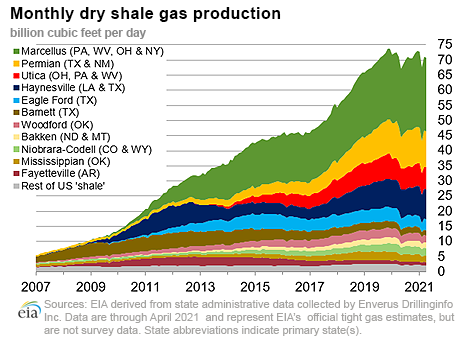In the News:
Ethane exports surge with additional export capacity and expanded tanker fleet
Ethane exports surpassed 370,000 barrels per day (b/d) in March, including more than 280,000 b/d of waterborne exports, a new all-time high. We expect ethane exports to remain high through the end of the year with nearly all growth associated with exports to China. U.S. ethane first reached China in 2019, joining a handful of other countries with ethylene crackers that rely on ethane feedstock imported from the United States. U.S. waterborne ethane exports began in 2016, when the first marine export terminals began operations, and have expanded from 95,000 b/d in that year to 277,000 b/d in 2019. The new markets for U.S. waterborne ethane exports included Europe, Asia, and Latin America. Ethane exports were relatively flat from 2019 to 2020, growing just 4,000 b/d. We expect ethane export growth to accelerate this year and next, averaging 374,000 b/d and 447,000 b/d in 2021 and 2022, respectively, according to the June Short-Term Energy Outlook.
Although most U.S. ethane production is consumed domestically, exports account for an increasing share of total demand. In 2020, about 16% of U.S. ethane production was exported, rising from zero in 2013. The United States is the largest ethane exporter in the world, and Norway is a distant second. Waterborne ethane exports have grown rapidly since 2016, when two waterborne export terminals, one in Marcus Hook, Pennsylvania, and then another in Morgan’s Point, Texas, began shipments. On an annual basis, in 2020, 67% of U.S. ethane exports were waterborne, and we expect waterborne exports to grow as the third marine export terminal, the Orbit terminal in Nederland, Texas, reaches full contracted capacity.
In addition to new export capacity, the capacity to ship ethane has also grown rapidly. Tankers that can carry ethane range from coasters that can carry ethane or ethylene over short distances to very large ethane carriers (VLECs) designed to carry up to 1 million barrels on intercontinental routes. The temperatures required to transport ethane and ethylene in their liquid states are much lower compared to other hydrocarbon gas liquids (HGLs). Propane is a liquid at -44oF, but ethane requires cryogenic temperatures to condense to a liquid state at -128oF. As a result, fewer vessels are available to ship ethane overseas, and most of these vessels have only been in service since 2016, when the first U.S. marine export terminals became operational.
Four types of ethane/ethylene vessels have serviced U.S. ports since 2018: coasters, handysize, midsize, and VLECs.
- Coasters: The smallest category of ethane carriers generally serve shorter routes that do not require deep-water transits. Since 2018, 11 coasters with an average ethane cargo capacity of 109,000 barrels have called on U.S. terminals to transport U.S. ethane to Mexico and Brazil.
- Handysize: These carriers, which are larger than coasters, mostly serve the Atlantic Basin markets. Since 2018, 17 handysize ethane/ethylene tankers with an average ethane/ethylene cargo capacity of 217,000 barrels have called on U.S. terminals.
- Midsize: Most U.S. ethane exports to date have left U.S. terminals on midsize vessels, which were built to carry ethane from the United States to overseas destinations. There are 16 midsize ethane carriers in service with an average capacity of 320,000 barrels, and they are all dedicated to carrying ethane from U.S. terminals. On average, two to three midsize ethane carriers depart U.S. terminals every week for destinations around the world.
- VLEC: The largest vessel class for ethane carriers can hold up to 1 million barrels of ethane, and they are all dedicated to routes from U.S. export terminals to destinations in Asia. VLECs are more similar in design to liquefied natural gas (LNG) carriers than to other product tankers because they are designed to carry cryogenic liquids in large, membrane-lined tanks. The first six VLECs, all chartered to Reliance of India, entered service starting in 2016. Since then, eight more VLECs have entered service. The most recently-completed six vessels entered service early this year and are dedicated to shipping ethane between the Orbit export terminal in Nederland, Texas, and the first Satellite Petrochemical ethane cracker in Lianyungang, China. Another six VLECs, dedicated to a route between Orbit and the second Lianyungang cracker, will enter service near the end of the year.
Overview:
(For the week ending Wednesday, June 9, 2021)
- Natural gas spot prices rose at most locations this report week (Wednesday, June 2 to Wednesday, June 9), as significantly warmer-than-normal temperatures across most of the country, aside from the West Coast, increased air conditioning demand, which resulted in high natural gas demand for power generation. The Henry Hub spot price rose from $3.05 per million British thermal units (MMBtu) last Wednesday to $3.10/MMBtu yesterday.
- The price of the July 2021 NYMEX contract increased 5¢, from $3.075/MMBtu last Wednesday to $3.129/MMBtu yesterday. The price of the 12-month strip averaging July 2021 through June 2022 futures contracts climbed 6¢/MMBtu to $3.108/MMBtu.
- The net injections to working gas totaled 98 billion cubic feet (Bcf) for the week ending June 4. Working natural gas stocks totaled 2,411 Bcf, which is 14% lower than the year-ago level and 2% lower than the five-year (2016–2020) average for this week.
- The natural gas plant liquids composite price at Mont Belvieu, Texas, the main pricing and storage hub for hydrocarbon gas liquids on the Gulf Coast, rose by 30¢/MMBtu, averaging $8.25/MMBtu for the week ending June 9. The price of ethane increased by 2% - less than the price of natural gas at the Houston Ship Channel, a pricing point close to Mont Belvieu, which increased by 3% week over week. The prices of propane and natural gasoline both rose 3%, which is consistent with rising price of Brent crude oil, which also increased by 3%. Prices of butanes rose the most. The weekly average normal butane spot price increased by 8%, and the price of isobutane rose 7%. Total butane exports have been high this year, reaching 439,000 b/d in March (latest available data), the highest level on record.
- According to Baker Hughes, for the week ending Tuesday, June 1, the natural gas rig count decreased by 1, falling for the fourth straight week, and now stands at 97. The number of oil-directed rigs remained constant at 359. The total rig count decreased by 1, and it now stands at 456.
Prices/Supply/Demand:
Prices on the Gulf Coast rise in response to above-normal temperatures and a nuclear power plant outage in Texas. This report week (Wednesday, June 2 to Wednesday, June 9), the Henry Hub spot price rose 5¢ from $3.05/MMBtu last Wednesday to $3.10/MMBtu yesterday after declining as low as $2.96/MMBtu on Friday. The Comanche Peak Nuclear Power Plant, located southwest of Dallas, Texas, is operating at 50% capacity, resulting in a loss of 1,200 megawatts (MW) of power generation capacity. This loss of capacity occurred during a period of above-normal temperatures, when electricity demand for air conditioning was already on the rise. As a result, natural gas consumption for power generation increased in the region. IHS Markit estimates natural gas consumption for power generation in Texas rose by almost 1 billion cubic feet per day (Bcf/d) since Sunday, the day before the nuclear reactor went offline.
Midwest prices rise as a heat wave sweeps across the region. At the Chicago Citygate, the natural gas price increased 10¢ from $2.97/MMBtu last Wednesday to a weekly high of $3.07/MMBtu yesterday. The Natural Gas Intelligence Midwest Regional Average price increased 8¢, from $2.92/MMBtu last Wednesday to $3.00/MMBtu yesterday, after hitting a weekly high of $3.03/MMBtu on Tuesday. The temperature in Chicago hit a daily high of 81°F on Tuesday, 12°F above normal, before falling slightly to an average of 80°F on Wednesday, 10°F above normal. Temperatures to the west of Chicago rose higher. Minneapolis hit a daily high of 96°F on Tuesday, 19°F above normal. The daily high on Wednesday was also 96°F, which beat the previous record, set in 1976, by 1°F.
Temperatures in California fall, reducing air conditioning demand. After setting all-time daily records just last week, temperatures in California declined rapidly this week. Temperatures in Bakersfield, which reported a daily high of 106°F last Wednesday, declined to a daily high of 78°F yesterday, 12°F below normal. IHS Markit estimates California demand for natural gas-fired power generation fell almost 1.0 Bcf/d between last Wednesday and yesterday. The price at PG&E Citygate in Northern California fell 18¢, down from $4.05/MMBtu last Wednesday to $3.87/MMBtu yesterday, after falling to a weekly low of $3.81/MMBtu on Tuesday.
Prices in Southern California also fell this report week. The price at SoCal Citygate decreased 98¢ from $4.48/MMBtu last Wednesday to $3.50/MMBtu yesterday after falling as low as $2.99/MMBtu on Friday. Prices in the Permian Basin, the main supply region into Southern California, fell, reducing cost of supply. You can find more information on this price decrease in the Permian Basin discussion below.
Prices in other western markets also decline week over week. The price at Sumas on the Canada-Washington border fell 14¢ from $2.95/MMBtu last Wednesday to $2.81/MMBtu yesterday. Prices at Opal in southwest Wyoming, the main trading point for natural gas in the Rocky Mountain region and the origin point for deliveries into the California market through the Ruby Pipeline, fell 21¢ from $3.07/MMBtu last Wednesday to $2.86/MMBtu yesterday. Both pricing points reported weekly lows on Friday of $2.61/MMBtu at Sumas and of $2.65/MMBtu at Opal.
Prices in the Northeast rise with increased demand, impaired supply. Temperatures across the Northeast rose significantly week over week. At Boston Logan International Airport, the daily high remained above 90°F for most of the report week. Boston temperatures reached 96°F on Monday and 95°F on Tuesday, close to all-time daily highs, which was 23°F and 21°F above normal, respectively. Temperatures declined slightly Wednesday, reaching a daily high of 90°F, 16°F above normal. IHS Markit reports Northeast natural gas consumption for power generation reached approximately 11.5 Bcf/d at the peak of the heat wave on Monday and Tuesday, more than 4.0 Bcf/d higher than at the end of the previous report week. At the Algonquin Citygate, which serves Boston-area consumers, the price went up 39¢ from $2.23/MMBtu last Wednesday to $2.62/MMBtu yesterday after reaching a weekly high of $3.65/MMBtu on Monday. At the Transcontinental Pipeline Zone 6 trading point for New York City, the price increased 12¢ from $2.18/MMBtu last Wednesday to $2.30/MMBtu yesterday. Prices in the New York area were highest on Tuesday, when Transco Zone 6 reached $2.98/MMBtu.
Prices in the Appalachia Basin production region are mixed as pipeline maintenance and increased demand results in market dislocation. The Tennessee Zone 4 Marcellus spot price increased 45¢ from $1.49/MMBtu last Wednesday to $1.94/MMBtu yesterday. As a result of higher demand in the Northeast region, the Tennessee Zone 4 price reached a weekly high on Tuesday of $2.01/MMBtu.
Takeaway capacity on the Texas Eastern Pipeline, which declared a force majeure on June 1, remains impaired, reducing the ability to ship natural gas out of the southwestern region of the Marcellus play by more than 0.7 Bcf/d. Columbia Gas Transmission, a pipeline operator in the region, also declared a force majeure at their Waynesburg, Pennsylvania, C14 location on June 3 in response to the outage on the Texas Eastern Pipeline. Flows past the C14 compressor station in the production area dropped by 230 million cubic feet per day (MMcf/d), from 280 MMcf/d before the outage to 50 MMcf/d going forward. Both the Texas Eastern Pipeline force majeure and the Columbia Gas Transmission force majeure are still in effect and have no defined end dates. The reduced takeaway capacity out of the region has resulted in the price at Eastern Gas South (formerly known as Dominion South until June 1, 2021) in southwest Pennsylvania falling another 1¢ from $2.01/MMBtu last Wednesday to $2.00/MMBtu yesterday, after declining by 22¢ last week, even as demand for natural gas and prices at other points in the Northeast all rose week over week.
Prices in the Permian production basin decline as production grows. The price at the Waha Hub in West Texas, which is located near Permian Basin production activities, fell 13¢ week over week from $2.91/MMBtu last Wednesday to $2.78/MMBtu yesterday. The Waha price yesterday was 32¢/MMBtu lower than the Henry Hub price—a larger discount this week than the 14¢/MMBtu discount to the Henry Hub price the previous report week. IHS Markit estimates production in the Permian Basin has consistently averaged more than 13.2 Bcf/d this report week, the highest weekly average on record, resulting in constrained takeaway capacity that placed downward pressure on prices in the region.
U.S. dry natural gas production tops 93.0 Bcf/d. According to data from IHS Markit, the average total supply of natural gas rose by 1.2% compared with the previous report week. Dry natural gas production grew slightly by 0.4% compared with the previous report week to 93.3 Bcf/d. The last time weekly average U.S. dry gas production exceeded 93 Bcf/d was the last week of March 2020, according to data from IHS Markit. Average net imports from Canada increased by 19.8% compared with the last report week to 4.6 Bcf/d, about 0.5 Bcf/d below the five-year average (2016–2020) for this time period.
Increases in U.S. natural gas consumption are led by the electric power sector. Total U.S. consumption of natural gas rose by 6.4% compared with the previous report week, according to data from IHS Markit. Natural gas consumed for power generation climbed by 27.0% week over week as much higher-than-normal temperatures in the midwestern and eastern United States increased demand for cooling. Industrial sector consumption decreased by 2.8% week over week. In the residential and commercial sectors, combined consumption declined by 25.8% as demand shifted to the electric power sector for cooling. Natural gas exports to Mexico decreased 1.0%. Natural gas deliveries to U.S. liquefied natural gas (LNG) export facilities (LNG pipeline receipts) averaged 9.4 Bcf/d, or 1.50 Bcf/d lower than the previous report week. Maintenance at LNG facilities is typical during the shoulder seasons, spring and fall, which can lead to lower feedgas consumption and results in lower export volumes.
U.S. LNG exports decrease week over week. Seventeen LNG vessels (six from Sabine Pass, four each from Freeport and Corpus Christi, and three from Cameron) with a combined LNG-carrying capacity of 61 Bcf departed the United States between June 3 and June 9, 2021, according to shipping data provided by Bloomberg Finance, L.P. Three tankers were loading on Wednesday—one each at Cove Point, Corpus Christi, and Sabine Pass.
Storage:
The net injections into storage totaled 98 Bcf for the week ending June 4, compared with the five-year (2016–2020) average net injections of 92 Bcf and last year's net injections of 95 Bcf during the same week. Working natural gas stocks totaled 2,411 Bcf, which is 55 Bcf lower than the five-year average and 383 Bcf lower than last year at this time.
According to The Desk survey of natural gas analysts, estimates of the weekly net change to working natural gas stocks ranged from net injections of 88 Bcf to 106 Bcf, with a median estimate of 97 Bcf.
The average rate of injections into storage is 4% lower than the five-year average so far in the refill season (April through October). If the rate of injections into storage matched the five-year average of 8.4 Bcf/d for the remainder of the refill season, the total inventory would be 3,664 Bcf on October 31, which is 55 Bcf lower than the five-year average of 3,719 Bcf for that time of year.
More storage data and analysis can be found on the Natural Gas Storage Dashboard and the Weekly Natural Gas Storage Report.
See also:
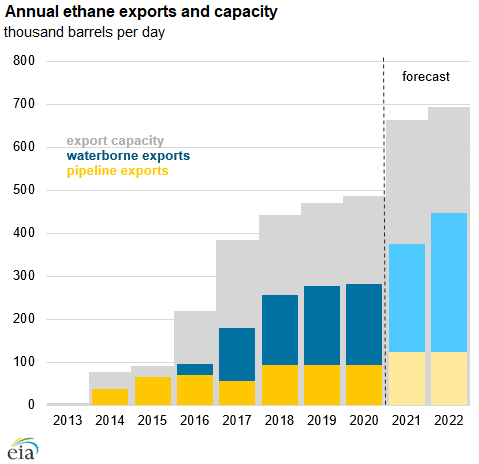 Source: Graph by U.S. Energy Information Administration, based on data from the Short-Term Energy Outlook, June 2021, and public company data
Source: Graph by U.S. Energy Information Administration, based on data from the Short-Term Energy Outlook, June 2021, and public company dataNote: Forecast values for exports are based on supply contracts.
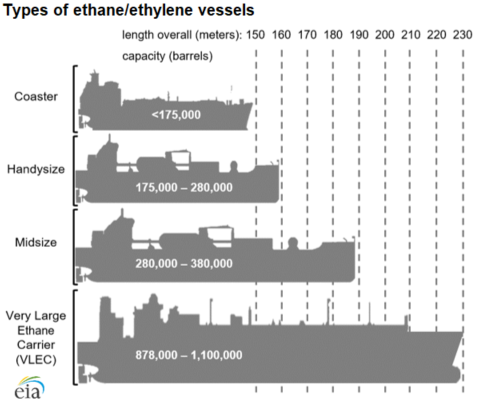 Source: Graph created by the U.S. Energy Information Administration based on data from Clipper Data and public data
Source: Graph created by the U.S. Energy Information Administration based on data from Clipper Data and public data Note: Vessels not to scale. Length overall is based on maximum lengths for each class.
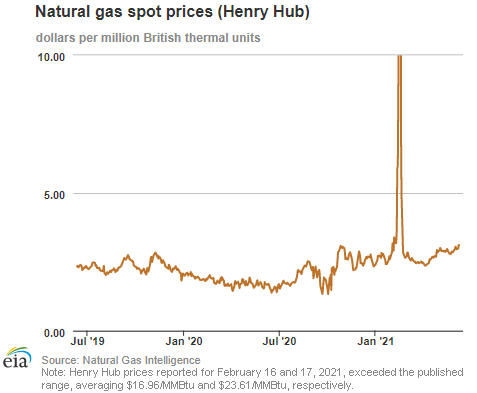
| Spot Prices ($/MMBtu) | Thu, 03-Jun |
Fri, 04-Jun |
Mon, 07-Jun |
Tue, 08-Jun |
Wed, 09-Jun |
|---|---|---|---|---|---|
| Henry Hub |
3.02 |
2.96 |
2.98 |
3.11 |
3.10 |
| New York |
2.10 |
2.69 |
2.86 |
2.98 |
2.30 |
| Chicago |
3.00 |
2.88 |
3.02 |
3.06 |
3.07 |
| Cal. Comp. Avg.* |
3.29 |
3.14 |
3.18 |
3.22 |
3.25 |
| Futures ($/MMBtu) | |||||
| July contract | 3.041 |
3.097 |
3.070 |
3.128 |
3.129 |
| August contract |
3.059 |
3.114 |
3.089 |
3.140 |
3.144 |
| *Avg. of NGI's reported prices for: Malin, PG&E Citygate, and Southern California Border Avg. | |||||
| Source: NGI's Daily Gas Price Index | |||||
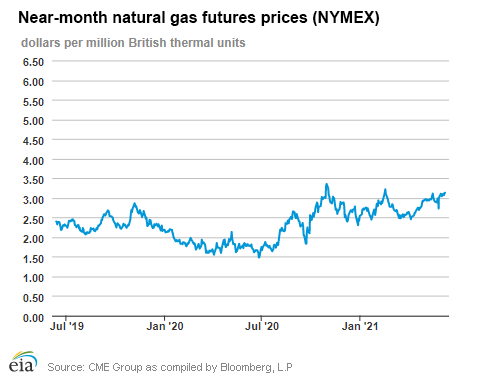
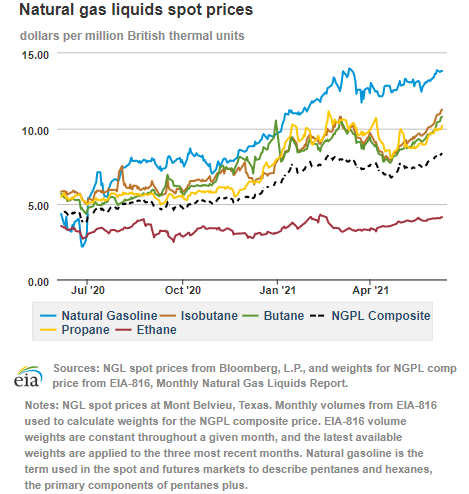
| U.S. natural gas supply - Gas Week: (6/3/21 - 6/9/21) | |||
|---|---|---|---|
Average daily values (billion cubic feet) |
|||
this week |
last week |
last year |
|
| Marketed production | 105.5 |
105.1 |
98.3 |
| Dry production | 93.3 |
92.9 |
87.3 |
| Net Canada imports | 4.6 |
3.9 |
3.8 |
| LNG pipeline deliveries | 0.1 |
0.1 |
0.1 |
| Total supply | 98.0 |
96.9 |
91.2 |
|
Source: IHS Markit | |||
| U.S. natural gas consumption - Gas Week: (6/3/21 - 6/9/21) | |||
|---|---|---|---|
Average daily values (billion cubic feet) |
|||
this week |
last week |
last year |
|
| U.S. consumption | 64.5 |
60.6 |
63.6 |
| Power | 35.4 |
27.9 |
34.7 |
| Industrial | 20.3 |
20.9 |
20.0 |
| Residential/commercial | 8.7 |
11.8 |
8.9 |
| Mexico exports | 6.5 |
6.5 |
5.3 |
| Pipeline fuel use/losses | 6.3 |
6.1 |
6.0 |
| LNG pipeline receipts | 9.4 |
10.9 |
4.2 |
| Total demand | 86.6 |
84.1 |
79.1 |
|
Source: IHS Markit | |||
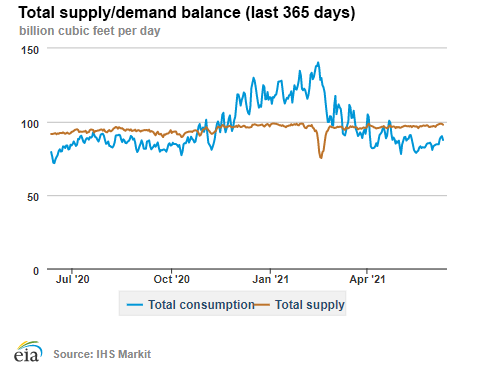
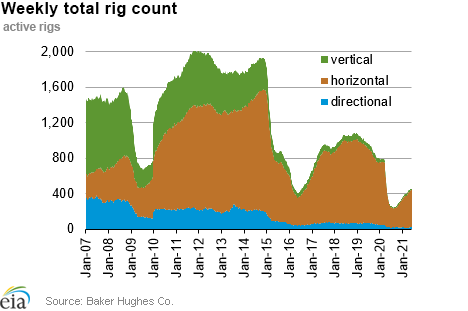
| Rigs | |||
|---|---|---|---|
Tue, June 01, 2021 |
Change from |
||
last week |
last year |
||
| Oil rigs | 359 |
0.0% |
74.3% |
| Natural gas rigs | 97 |
-1.0% |
27.6% |
| Note: Excludes any miscellaneous rigs | |||
| Rig numbers by type | |||
|---|---|---|---|
Tue, June 01, 2021 |
Change from |
||
last week |
last year |
||
| Vertical | 16 |
6.7% |
128.6% |
| Horizontal | 415 |
0.0% |
64.0% |
| Directional | 25 |
-7.4% |
4.2% |
| Source: Baker Hughes Co. | |||
| Working gas in underground storage | ||||
|---|---|---|---|---|
Stocks billion cubic feet (Bcf) |
||||
| Region | 2021-06-04 |
2021-05-28 |
change |
|
| East | 445 |
413 |
32 |
|
| Midwest | 547 |
522 |
25 |
|
| Mountain | 160 |
151 |
9 |
|
| Pacific | 276 |
268 |
8 |
|
| South Central | 983 |
959 |
24 |
|
| Total | 2,411 |
2,313 |
98 |
|
| Source: Form EIA-912, Weekly Underground Natural Gas Storage Report | ||||
| Working gas in underground storage | |||||
|---|---|---|---|---|---|
Historical comparisons |
|||||
Year ago (6/4/20) |
5-year average (2016-2020) |
||||
| Region | Stocks (Bcf) |
% change |
Stocks (Bcf) |
% change |
|
| East | 559 |
-20.4 |
476 |
-6.5 |
|
| Midwest | 658 |
-16.9 |
554 |
-1.3 |
|
| Mountain | 147 |
8.8 |
147 |
8.8 |
|
| Pacific | 280 |
-1.4 |
263 |
4.9 |
|
| South Central | 1,150 |
-14.5 |
1,027 |
-4.3 |
|
| Total | 2,794 |
-13.7 |
2,466 |
-2.2 |
|
| Source: Form EIA-912, Weekly Underground Natural Gas Storage Report | |||||
| Temperature – heating & cooling degree days (week ending Jun 03) | ||||||||
|---|---|---|---|---|---|---|---|---|
HDD deviation from: |
CDD deviation from: |
|||||||
| Region | HDD Current |
normal |
last year |
CDD Current |
normal |
last year |
||
| New England | 66 |
34 |
36 |
0 |
-4 |
-22 |
||
| Middle Atlantic | 52 |
29 |
33 |
1 |
-12 |
-20 |
||
| E N Central | 54 |
25 |
33 |
3 |
-18 |
-24 |
||
| W N Central | 47 |
23 |
31 |
9 |
-19 |
-22 |
||
| South Atlantic | 17 |
9 |
14 |
53 |
-4 |
-15 |
||
| E S Central | 17 |
10 |
15 |
35 |
-14 |
-15 |
||
| W S Central | 6 |
5 |
5 |
56 |
-24 |
-16 |
||
| Mountain | 27 |
-11 |
21 |
44 |
9 |
-20 |
||
| Pacific | 6 |
-19 |
-2 |
26 |
12 |
1 |
||
| United States | 33 |
11 |
21 |
26 |
-9 |
-16 |
||
|
Note: HDD = heating degree day; CDD = cooling degree day Source: National Oceanic and Atmospheric Administration | ||||||||
Average temperature (°F)
7-day mean ending Jun 03, 2021
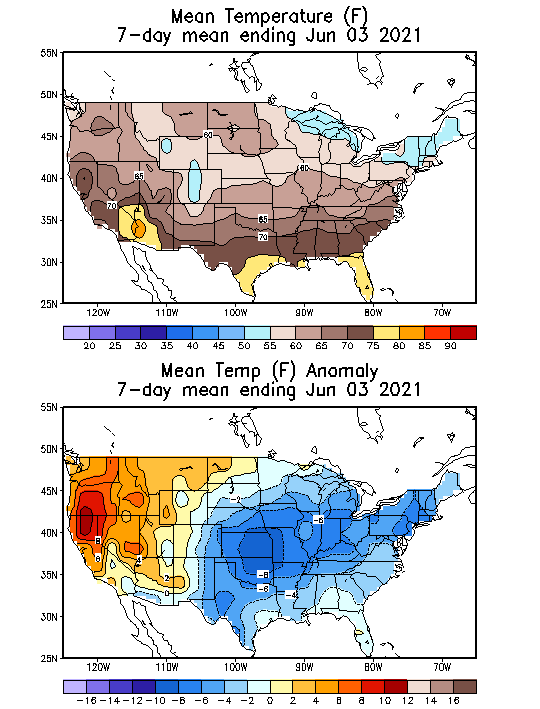
Source: National Oceanic and Atmospheric Administration
Deviation between average and normal (°F)
7-day mean ending Jun 03, 2021

Source: National Oceanic and Atmospheric Administration

